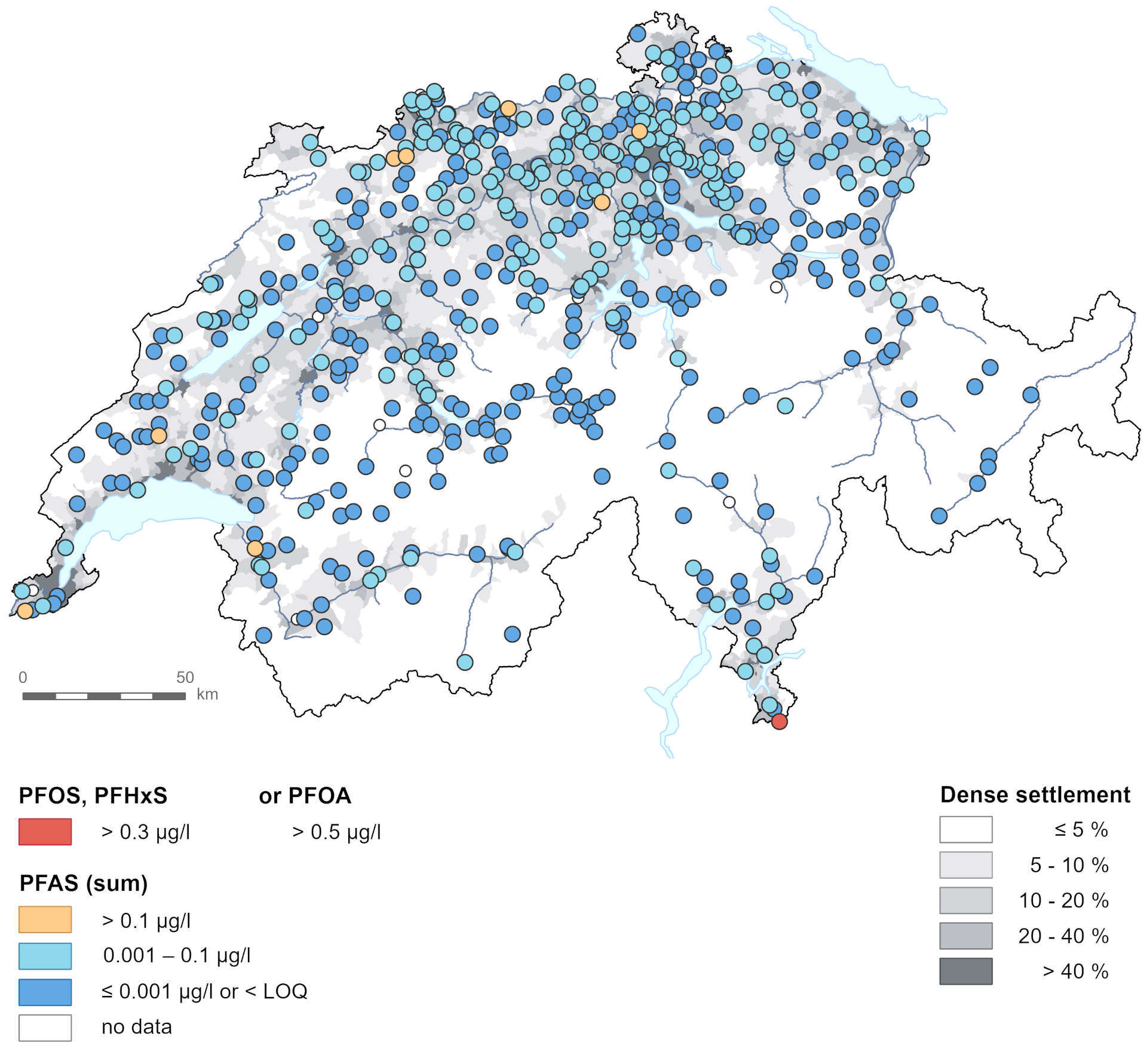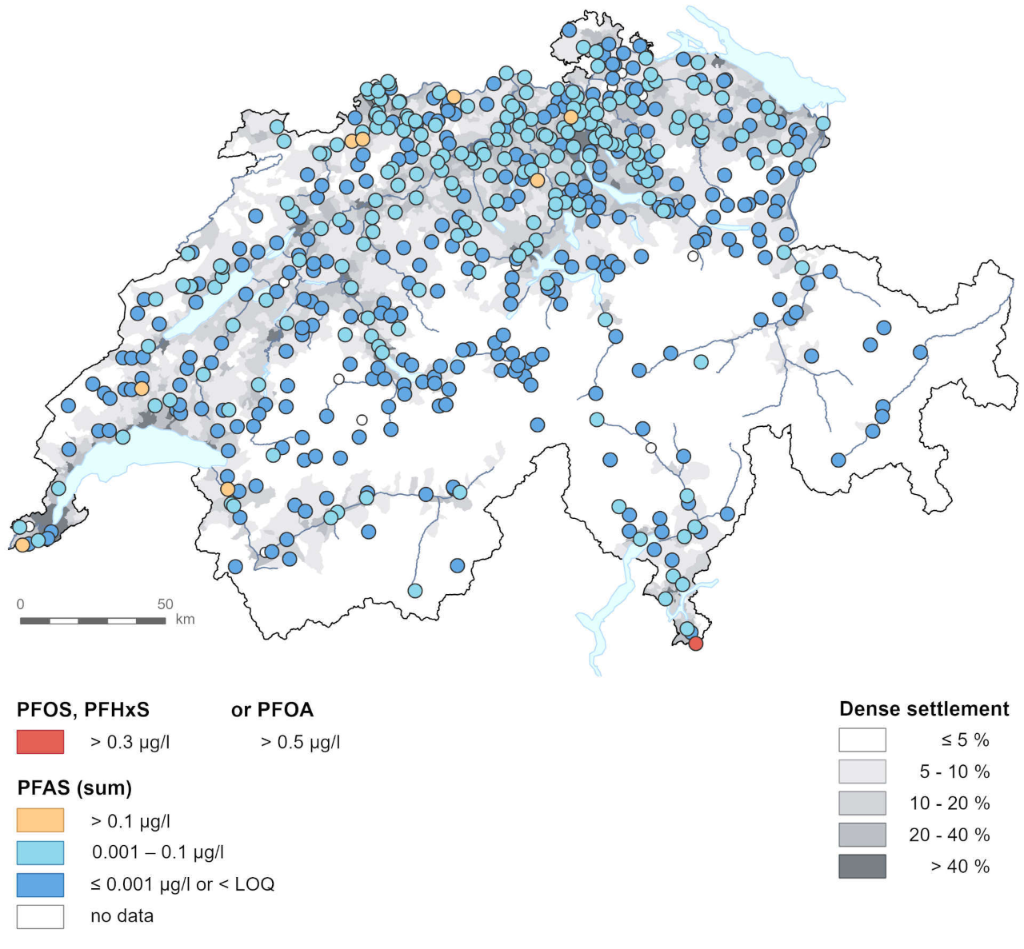Per- and polyfluoroalkyl substances (PFAS) are found in Swiss groundwater at almost half of the NAQUA monitoring sites. PFAS concentrations exceeding 0.1 micrograms per litre in groundwater are frequently due to the use of firefighting foams containing PFAS. These chemicals can also reach groundwater from landfill sites or via infiltration of river water.
PFAS are fully (per) or partially (poly) fluorinated organic chemicals. They are used in many commercial, industrial and household products due to their water and fat-repellent properties as well as their thermal and chemical stability. These include fire suppression foams, waterproofing agents, water and fat-repellent food packaging, non-stick pans, breathable water-repellent clothing and ski wax.
Several thousand PFAS are manufactured industrially. Extremely long-lasting, i.e. persistent, and mobile perfluorinated PFAS represent a major problem for groundwater. Mobile and persistent short-chain perfluorinated PFAS can also be formed during the degradation processes of longer-chain partially fluorinated and sometimes complex PFAS, so called polyfluorinated precursors. Owing to their persistence, they increasingly accumulate in the environment and could potentially have a detrimental impact on the environment and human health for many generations to come.
NAQUA pilot study
As part of the NAQUA National Groundwater Monitoring, a pilot study took place in 2021 during which approximately 550 NAQUA monitoring sites were sampled for the analysis of 26 different PFAS that can be reliably quantified using common, standardised analytical methods. They include the 20 PFAS for which a limit value applies in drinking water in the EU.
The analytical method and quantification focused initially on the linear PFAS isomers. For PFOS (C8) and PFHxS (C6), the concentration of the branched isomers was also estimated. The analytical limit of quantification was between 0.001 and 0.0005 micrograms per litre (µg/l).
PFAS had been analysed and detected in Swiss groundwater for the first time at a small number of monitoring sites in 2007 and 2008 as part of a NAQUA pilot study.
Perfluorierte Chemikalien im Grundwasser (PDF, 768 kB, 03.02.2011)gwa 2010/11: 967-978
PFAS in groundwater widespread, but rarely exceeding current limits
PFAS are detected in groundwater at almost half of the NAQUA monitoring sites. The concentration sum of the 26 PFAS analysed is above 0.01 micrograms per litre (µg/l) at around 25 % of the monitoring sites and above 0.1µg/l at around 2 %.
The DWBSO’s currently applicable maximum values for drinking water are exceeded in groundwater at only one of the NAQUA monitoring sites. This is due to PFOS whose concentrations exceeds the DWBSO’s current maximum limit for this substance of 0.3 µg/l.
Limits for groundwater and drinking water
Groundwater that is used or intended for use as drinking water must, in accordance with the Waters Protection Ordinance (WPO), comply with the maximum values for drinking water under food legislation, after basic treatment if necessary. This means the maximum values of the FDHA Ordinance on Drinking Water and Water in Public Baths and Shower Facilities (DWBSO) also apply as chemical parameter limits for groundwater unless the WPO contains separate limits.
Since 2017 the DWBSO mentions a maximum value of 0.3 micrograms per litre (µg/l) for PFOS (C8) and PFHxS (C6), and a maximum value of 0.5 µg/l for PFOA (C8). These maximum values are currently being revised by the Federal Food Safety and Veterinary Office (FSVO). This revision is based on the new requirements established to drinking water in the EU in 2021 according to the EU drinking Water Directive. In Switzerland the current maximum values for PFOS (C8), PFHxS (C6) and PFOA (C8) will probably be replaced by a maximum value of 0.1 µg/l for the sum concentration of 20 specified PFAS. The DWBSO’s new maximum value for PFAS in drinking water shall apply, aligned with EU implementation, from 2026.
Bundesamt für Lebensmittelsicherheit und Veterinärwesen BLV: PFAS
For groundwater, the European Commission proposed a (toxicologically weighted) limit of 0.0044 µg/l for the sum concentration of 24 PFAS in 2022. This limit is based on the threshold value set by the European Food Safety Authority (EFSA) for the sum concentration of four PFAS – PFOA (C8), PFNA (C9), PFHxS (C6) and PFOS (C8). The proposal for a limit value in groundwater is currently being discussed in the ongoing EU legislative process.
In order to assess whether a polluted site must be remediated in accordance with the Contaminated Sites Ordinance (CSO), a (toxicologically weighted) concentration value of 0.05 µg/l is currently applied for the sum of 9 PFAS. As part of the implementation of the Maret motion (22.3929), it is being examined whether this value can be included in the CSO.
The value of 0.1 µg/l, the EU limit for the sum concentration of 20 PFAS in drinking water, is exceeded at approximately 2% of the NAQUA monitoring sites.
The value of 0.0044 µg/l, which the European Commission proposed as a limit for the (toxicologically weighted) sum concentration of 26 PFAS in groundwater, is exceeded at around 25 % of the NAQUA monitoring sites.
Most PFAS detections are localised in urban areas, where PFAS are found at over 90% of the monitoring sites. The Swiss Plateau and Jura regions are affected to approximately the same extent, whereas PFAS were detected more rarely in the Prealps and Alps.
A total of 13 different PFAS have been identified in groundwater so far. PFOS (C8) and PFHxS (C6) are found in the highest concentrations. Both PFAS exceed 0.1 µg/l at a small number of monitoring sites, and PFOS even exceeds the DWBSO’s maximum value of 0.3 µg/l at one monitoring site. The use of PFOS has been strictly regulated in Switzerland since 2011 and the use of PFHxS has been prohibited since 2022.
PFOA (C8), which has been strictly regulated in Switzerland since 2021, is detected at many monitoring sites, but in concentrations well below 0.1 µg/l. PFNA (C9), which has been banned since 2022, is found very rarely in groundwater and in very low concentrations.
Short-chain and therefore mobile perfluorinated PFAS (such as PFBS (C4), PFBA (C4) and PFHxA (C6)), which are often used as a substitute for the now prohibited longer-chain substances PFOS (C8), PFOA (C8) and PFHxS (C6), are found just as frequently in groundwater as these long-chain PFAS. Of the newer partially fluorinated PFAS analysed, only 6:2-FTS was detected. It is used as a replacement for PFOS, for example in fire suppression foams and hard chrome plating. Neither long-chain perfluorinated carboxylic acids with more than 9 carbon atoms nor long-chain perfluorinated sulphonic acids with more than 8 carbon atoms were detected at any NAQUA monitoring site. They are bioaccumulative, but not very mobile.
Local contamination from firefighting foams
Information provided by the cantonal authorities indicates that PFAS-containing fire fighting foams were used in the past in the catchment area of almost all NAQUA monitoring sites where the sum concentration of PFAS exceeds 0.1 µg/l in groundwater. These are sites of accidental fires or training areas of civil protection, industrial sites, fuel depots or railway territory where PFAS have been released to the soil and subsoil, in some cases repeatedly. PFOS and PFHxS account for 50 to 60% of PFAS contamination of the groundwater at these monitoring sites.
At monitoring sites near rivers, PFAS may originally come from industrial or communal waste water. They enter the treatment plants via wastewater, from which they get into watercourses with the treated wastewater and eventually seep into groundwater through infiltration of river water. Rivers which contain a relatively high amount of (treated) wastewater in relation to the water volume, such as the Glatt, Ergolz or Birs, PFAS might enter groundwater along the entire river section. However, the average PFAS concentrations in the large and medium-sized watercourses, which feed groundwater ressources to a significant extent in the unconsolidated aquifers of river valleys , are generally below 0.1 µg/l.
In parallel to the pilot study in groundwater, samples from 12 selected watercourses were analysed in 2021 to gain an initial impression of their pollution levels. Over a period of 2 to 6 months, twelve monitoring sites of the National River Monitoring and Survey Programme NADUF and four cantonal monitoring sites on large and medium-sized rivers were sampled and analysed for 22 different PFAS.
All water samples were found to contain PFAS. The sum concentration of the 22 PFAS in the watercourses was a maximum of 0.05 µg/l, well below the peak concentrations detected at some groundwater monitoring sites.
The highest contamination levels were detected in the rivers Glatt, Ergolz and Birs, with concentrations exceeding 0.01 µg/l. Besides Weil am Rhein and Chancy (downstream of Lake Geneva), this is where most substances were detected. The catchment areas of these water bodies are densely populated and intensively used for commercial and industrial purposes. The Rhine, Aare, Limmat, Reuss, Thur, Kleine Emme and Wiese rivers showed average sum concentrations below 0.01 µg/l. Concentrations were generally lower in the Inn and in the Rhone near its confluence with Lake Geneva.
12 of the 22 PFAS analysed were detected. PFBA (C4) was particularly abundant in surface waters, occurring in 98% of samples.
Groundwater quality on site
All data gathered as part of the NAQUA National Groundwater Monitoring is available to the cantonal authorities. The water companies concerned have also been informed about the results. The cantonal authorities are responsible for providing detailed information on groundwater quality of a specific region or location. Consumers can obtain information on drinking water quality directly from their water companies.
Further information
Last modification 12.10.2023







